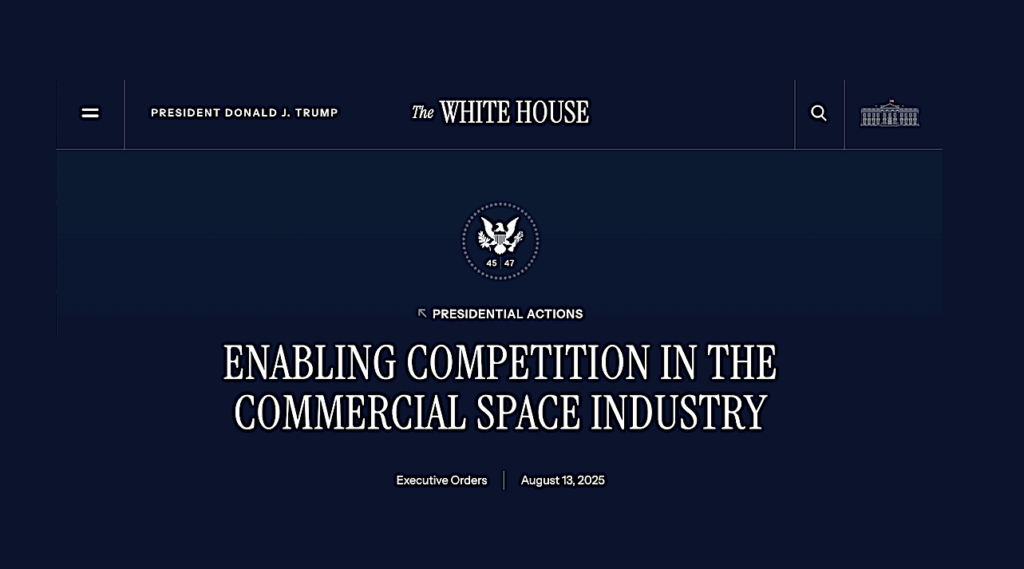Pro- and Anti-Commercial Space Factions Are Fighting

Trump advisers’ space plan: To moon, Mars and beyond, Politco
“Former House Speaker Newt Gingrich, another commercial space evangelist with close ties to Trump, is also pushing the White House to embark on a major effort to privatize U.S. space efforts. “A good part of the Trump administration would like a lot more aggressive, risk-taking, competitive entrepreneurial approach to space,” Gingrich said in an interview. “A smaller but still powerful faction represents Boeing and the expensive old contractors who have soaked up money with minimum results.
“It is a big fight,” said former Republican Rep. Robert Walker of Pennsylvania, who drafted the Trump campaign’s space policy and remains involved in the deliberations. “There are billions of dollars at stake. It has come to a head now when it has become clear to the space community that the real innovative work is being done outside of NASA.”
– Commercial Spaceflight Federation Sells Out and Endorses SLS (Update), earlier post
– Trump Transition Team Wants Old Space Vs New Space Smackdown, earlier post
– Economic Assessment and Systems Analysis of an Evolvable Lunar Architecture that Leverages Commercial Space Capabilities and Public-Private-Partnerships, Charles Miller et al, Research Gate









“The Moon by 2020” seems a bit unlikely, although orbiting the Moon by 2020 might be possible. If this plan actually leads to more NASA funding for commercial spaceflight and spaceflight in general I’ll be happy (although not happy if they keep the budget the same but redirect funding away from Earth Science and the robotic programs to this).
Congress has not allowed the industry nor its agency employees to innovate for decades. For example: 1970s Shuttle, 2010s Shuttle 😉
“1992: Not even $100M could be found in the budget for cost effective access to space”
“2004: Depot centric cast aside for expendable HLV, Apollo Redux”
Congress to NASA: 6B on SLS//Orion/ISS..guts technology.
Only folks with 100M or so have ‘innovations’ ready to fly by 2020.
A ‘private’ station rather than variable gravity research? !
More funding… Promises.. Promises.
‘Mooning’ has nothing to do with long duration deep space travel and crew health.
The longer Mars advocates block a return to the Moon, the longer it will take to get to Mars even with a simple “Flags and Footsteps” mission. The Moon has everything to do with moving beyond Earth orbit.
Please specify why. wrong g,GCR,3days Problems:
Congress: retains decades old expendable hardware
LVs: low flight rate and excess capacity
NASA: *requires* reuseable common hardware t
Congress: lacks any description of the architecture, spacecraft, or systems needed to achieve this goal
Congress: fails to accept the projected the cost of such voyages or cancel the programs in the way.
Obvious solution:
– consolidate SLS/Atlas/Delta into a single LV
– new LVs goal: complete reuse; allow ‘Deltas’
– 2+ LVs with adequate flight rate;
– common configurations for class A cargo/crew
– a LV independent architecture for BEO, yet flexible
– dirt cheap propellant for LV certification. The reward is with little financial risk for demonstrated reliability and significantly lower launch costs
Not one shot flags and footprints head in the sand lets do mooning again…
“consolidate SLS/Atlas/Delta into a single LV”
Why not ditch all three of these since they’re all far too expensive and let ULA finish developing Vulcan?
Because Vulcan v0 needs a redesign, but yes that is inferred. Why certify Atlas for crew when it will be retired, has solids, and RD180s? Further, its unlikely, due to solids, of achieving the 1:1000 LOC. Even Vulcan v0 flies crew without solids, but this results in a non-common configuration for Class A cargo/crew. Now about those dropped engines and parachute catches…..
What people fear is that if NASA goes to the moon it will get bogged down by the same forces in congress and there will never be a dime left over in funding to add the tools to the toolkit we need to push on to mars.
I have no dog in the fight because I advocated for staying out of gravity wells until commercial transportation can take you from earth to the lunar surface and home again. I want NASA purchasing services and then R&D on the bleeding edge.
Its a much better place to be stuck than LEO. At least you are exploring a new world.
That’s the point Thomas, Mars advocates don’t want that .. they see is as we have been there already and lets do the new place. It is why I have avoided that debate for over a decade.. and tried to focus instead on creating transportation systems and a fierce competitive launch sector for delivering fuel and oxidizer to LEO and commercial fuel station. Don’t get bogged down anywhere because you can go anywhere, just avoid the deep gravity wells until then.
I can see both sides but to me it is nothing more than people shouting “More filling! – Tastes great!”
Exactly. Without routine and therefore by necessity affordable and sustainable access to Earth’s nearest heavenly body and the resulting infrastructure, any trip to Mars will be a one off stunt, doomed to the same result as Apollo.
The critical requirement for getting to the Moon or Mars is a dramatic reduction in the cost of human flight to LEO. But Congress still controls the program and will only shift resources to commercial crew, let alone technology development, if there is overwhelming pressure to do so. I doubt that
Trump will spend any political capital trying to change it.
Where have you been for the last decade? Ever heard of DigitalGlobe as an example of the imaging industry?? Ever heard of the many commercial communications satellites??? Other countries and their satellites and innovations and new industries?? The government space program does move at a glacial pace but there has been tremendous innovation in the last ten years and even before. OrbitalATK and SpaceX and Sierra Nevada – some has been done with government money but a lot has been done with commercial investment.
There are many examples that I do not have space to list.
If we can use the innovation of the commercial actors we are going to make real progress.
I presume that muomega0 is talking specifically about the human (manned) spaceflight aspect of NASA’s mission.
Tritium3H – I agree that muo thinks that “space” means “people flying into space” and one of my points is that his notion has been wrong for years. The SpaceX capsule (now called Crew Dragon apparently) owes a lot to Falcon 9, which owes some to Falcon 1. But the imaging industry would not be as successful as they are unless they could get a payload into space economically. We do not need Congress to “allow” the industry to innovate, we need Congress to get out of the way and allow industry to innovate.
Teledesic, Iridium, Globalstar likely would have succeeded with lower launch costs. But even ULA is not sold on reuse without flight rate, and a ‘mission to the moon is the response’ Pathetic.
If you do not understand #1 Economic Access to Space, you do not understand the issues facing NASA and ‘new markets’. You could have the greatest innovation in the world, but worthless if it costs 1B/launch.
The shuttle is pretty much the same vehicle that it was in the 1970s.
Pretty much the same, except for all of the fixes and upgrades done along the way. This is along the lines of the changes made to the B-52s over the years. Yes they look the same on the outside, but they’re different enough in the details that the shuttle which was retired was far safer and more capable than when Columbia first flew STS-1.
Actually launch costs were only a minor element of the cost structure.
Both Iridium and Globalstar failed because they spent billions providing a communication service to the entire surface of the Earth, while ignoring 95% of humanity activity takes place on only 5% of the Earth’s surface. The majority of the rest of human activity uses links from comsats in GEO. Its hard to close a business model on such a small market share.
Teledisic recognized this and didn’t move forward as a result.
Its the classic example of an idea that works technically but ignores market reality. The new Iridium survives because it recognized and adapt its business model to that niche market successfully.
You didn’t expect the denizens of the swamp to go quietly did you? After all NASA has survived on pork since Project Apollo ended. So its not surprising the entitlement empire is fighting for their pork.
But hopefully those who want NASA to explore, develop and open space for all Americans and not just a handful of scientists will win. Hopefully the advocate community is joining the fight to open space up for Americans.
That actually would make America great again.
…joining the fight to open space up for a “handful” of American BILLIONAIRES you mean?
Those businesses are servicing their customers, not taking private personal joyrides.
If you start moving now you could probably put a Bigelow Aerospace B330 at the EM L1 by then and service it with a Dragon2. They could operate some rovers from it as a stop gap until a lunar lander is developed to transport astronauts from lunar orbit to the surface during President Trump’s second term.
Staging at L2 has many more advantages ‘to Mars’.
The B330 cannot provide variable gravity, nor full GCR protection…selling things to the USG it does not require.
You must be referring to the Old requirements under the Old Administration’s Old space program. This administration isn’t going to waste money on a decades long program to go to Mars to look for bacteria. Its is going to spend the money on space projects that provides near term benefits for the American economy the way Project Apollo benefited it.
Again its about draining the swamp and putting agencies like NASA to productive use 🙂
Oops, you must mean the asteroid that Orion could not reach–a decade old HSF stepping stone– or a mission similar to Rosetta with crew–that would be cool. ‘To Mars’ includes asteroids and the Martian moons with abundant resources, unlike ‘mooning’.
All the resources on the moon and Earth including the water arrived from asteroids, so rather than go ‘mooning’ and looking for a needle in large bucket of dust, head to the resources ‘in situ’. Address the Space Grand Challenges with numerous flights. ‘Mooning’ does not prepare NASA for Mars since it has the wrong gravity, GCR, and trip time.
Increasing flight rate will cut launch costs to create new Markets–Not happening with HLVs–they are too big. At Best, NASA needs 200mT/yr….that’s 2 SLS flights — 3B/yr 🙂
No way would 2020 be possible unless a lunar orbit only mission counts as a “return to the moon”.
I’m pretty sure Musk would be willing to accept that challenge. (Not saying they could actually pull it off on that timeframe, just that they would think they can now.)
“rapid and affordable”
Let’s refer to the rule “good, fast, cheap. Pick any two.” So far what is specified is fast and cheap which means is not good (either limited capability or very dangerous).
I’d like to see younger generation i.e. Muskees focus on the Moon and rid this Mars nonsense (that planet will always be 20 years away for human exploration). I see lots of reference of Apollo which I wonder if that program (amazing as it was) has become “baggage” limiting the way people think and plan for lunar activities.
Rapid and affordable – we can pick one of those two.
This is a space transportation architecture choice.
1. SLS + Orion
or
2. Commercial crew + commercial cargo + commercial HLV.
One of these architectures is absolutely more rapid and affordable than the other. When SLS first flies, it will do so without its own upper stage. Instead, it will fly with an Interim Cryogenic Propulsion Stage (ICPS), which is a modified Delta IV 5–meter Delta Cryogenic Second Stage (DCSS). So, SLS has yet to finish development its own upper stage and beyond that there are another anticipated upgrades as well. SLS development is not even close to done.
Are they really calling it an “interim” stage? That’s just a bad omen to anyone who can remember the mid-1980s. The shuttle originally used a “Interim Upper State” (IUS) to boost payload to geosynchronous transfer orbit. It was _supposed_ to be a temporary practice, until they developed a good, safe, liquid-fueled state. After Challenger, that idea was dropped and the IUS was re-christened the “Inertial Upper Stage.” Given the history, a “Interim” Cyyogenic Propulsion Stage just implies the sort of “temporary” measures that end up being permanent.
The name change for IUS occurred prior to the Challenger tragedy.
Several issues related to Centaur in the shuttle’s payload bay were never solved. Not the least of which was how do you safely dump all that LH2 and LOX from Centaur in the event of any sort of in flight launch abort? Landing with a payload bay full load of LH2 and LOX wouldn’t have been “desirable”.
I’ve recently convinced myself that the old “cheaper, faster, better, pick two” joke isn’t really true. It may be true of a single mission, but not of a program. In this case, a cheap, fast return to the Moon might be very limited in its capabilities. But if it enabled a future, more capable mission, wouldn’t that be better overall?
Leaving out the fact that it’s pro- vs anti-commercial, the overlying motivations here remind me quite a bit of what I read regarding the Soviet space program
I didn’t read the entire Politico article, but Gingrich saying that Old Space has “minimal results” isn’t fair. They’ve launched lots of great stuff while soaking up all that money.
Also, Walker is forgetting that most of that innovation outside of NASA is being done by NASA partners, with NASA contracts, on NASA projects, and with NASA help.
How did the new administration so badly overestimate the power and authority of the President? How did they miss it so widely?
Foreign heads of state have overestimated the power of the US President (e.g. Stalin didn’t really get the idea that Roosevelt might not be reelected.) Also, Mr. Trump’s background is in managing a large organizations with _no_ checks or balances.
You are correct I think to point to 45’s background: knowledge of simple civics appears to just be missing.
BTW large corporations all have internal checks and balances of one sort or another. Much of this function is performed by the Board of Directors. In any case we are consumed in America with running our government as if it’s business, which it decidedly is not. Different rules, different goals, different needs entirely. And we shall lean that the government as business model doesn’t work very well.
I suspect that now we know the nature of the conversation that transpired between Mr. Musk and 45.
Use the Dragon trunk for any extra supplies needed and land on the trunk. Then take back off. The abort test left the trunk on, so the rockets clear. The usual drop the trunk off and land on Earth. The problem with a Moon station is boredom. In between landings and takeoffs who wants to watch the plants grow? Just watch ISS LIve on NASA TV to see how boring it would be. The flying and building would be fun. No, there is not a spot to land on the Moon to pick up gold nuggets for commercial interest. The only thing residents would do is maintenance. How about a tennis tournament to watch.
The 2nd stage would send Dragon to Luna. There are low energy ways, just takes longer. The Trunk could be in 2 parts and leave the empty fuel tanks that were used for landing. SpaceX has been landing a 50′ first stage, so a long Trunk should be ok. A long ladder though from the capsule. The Moon buggy would be on the bottom and easy to get to. I think the Supper Draccos are on or off. Have to be made variable. Pulsing might be ok. But that is needed to land on land anyway. I think this is the most likely way for ’20.
Bids take a long time though. A Space Act Agreement might work. All the testing and slips, I don’t think it can be done by ’20.
There’s an argument for a science base; but much of the science can be returned autonomously or by orbiting vehicles. There’s a ‘quiet zone’ of course on the far side, but even that is a marginal improvement over existing tech.
There’s a lot of geology (lunology, one supposes) to be done in situ, and much to be gained; but this could happen with sorties.